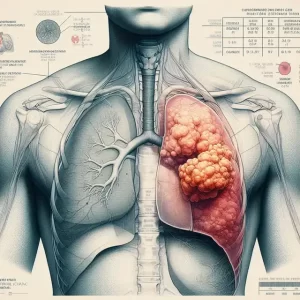Common Toxic Contaminants in US Drinking Water Sources Pose Health Risks to Millions
- FDA Approved Opdualag: The First Immunotherapy Targeting LAG-3
- Cutaneous Reactions Following COVID-19 Vaccination: A Review of the Evidence
- Brief Intermittent Exercise Reduces Heart Disease and Death Risk
- Personalized Lung Tumor Chips Assess PD-1 Therapy Response
- Study Shows Prior Infection Offers Strong Immunity to Original COVID-19 Strain
- Chinese Food Products Dominate Korean Tables Amid Safety Concerns
Common Toxic Contaminants in US Drinking Water Sources Pose Health Risks to Millions
- AstraZeneca Admits for the First Time that its COVID Vaccine Has Blood Clot Side Effects
- Was COVID virus leaked from the Chinese WIV lab?
- HIV Cure Research: New Study Links Viral DNA Levels to Spontaneous Control
- FDA has mandated a top-level black box warning for all marketed CAR-T therapies
- Can people with high blood pressure eat peanuts?
- What is the difference between dopamine and dobutamine?
- How long can the patient live after heart stent surgery?
Scientists Warn: Common Toxic Contaminants in US Drinking Water Sources Pose Health Risks to Millions.
A study from the University of New Mexico has revealed that many water wells and community water systems in the United States contain toxic contaminants, posing health risks to millions of people.
Those living in tribal lands or minority communities are particularly vulnerable.
The study identified seven major pollutants, including arsenic, lead, and PFAS. While large water supply systems can sometimes mitigate these contaminants, many Americans remain unprotected. Furthermore, climate change exacerbates the challenge of finding clean water sources, with underserved areas expected to be hit hardest.
New Mexico, USA – A recent study from the University of New Mexico has uncovered a concerning issue regarding the safety of drinking water in the United States.
Contrary to the assumption of many Americans that tap water is clean and safe to drink, the research, conducted by a scientist from the University of New Mexico in collaboration with colleagues across the nation, warns that numerous wells and community water systems contain unsafe levels of toxic contaminants, putting millions at risk of health issues, including cancer.
Published in the “Journal of Exposure Science and Environmental Epidemiology,” the study also highlights the disproportionately severe impact on those living in tribal lands or minority communities and predicts that climate change will make it increasingly challenging to find safe drinking water sources.

Background and Expert Commentary
Dr. Johnnye Lewis, Honorary Professor of Pharmaceutical Sciences and Chief Investigator of the Navajo Birth Cohort Study, stated that this paper was presented during a senior scientist meeting at the International Society for Exposure Science annual conference. Dr. Lewis is the Director of the Community Environmental Health Program and the New Mexico University Superfund Research Program.
“We have several individuals with expertise in handling these specific contaminants among us, but we found that, for various reasons, they are not always at safe levels in drinking water sources,” Lewis said.
The paper evaluated seven known pollutants that frequently enter drinking water: arsenic, fracking fluids, lead, nitrates, disinfection byproducts, and synthetic chemicals known as PFAS (per- and polyfluoroalkyl substances) and uranium. The capacity to detect and remove these substances from drinking water varies significantly.
Most of these substances, including inorganic arsenic, nitrates, uranium, and lead, are known or suspected carcinogens, and prolonged exposure to most pollutants is associated with various other health problems, including neurological and developmental issues.
“Some of these, like uranium and arsenic, even nitrates, are quite common,” Lewis said. “They typically occur in groundwater, and sometimes it’s the source you have access to.” Other pollutants, such as fracking fluids and PFAS, are introduced by human activity, representing unknown risks. For instance, PFAS can persist in the environment for decades without breaking down, a problem that has only recently been addressed. “I think there is indeed concern, but it wasn’t at the scale it is now; it has escalated to this point. It’s like many things we do as a society. You take action first and then try to figure out solutions. It’s usually a bad strategy.”
Contaminants: Scale and Impact
The authors report that these seven pollutants represent only a small fraction of the thousands of chemicals found in drinking water. Complicating matters further, water sources may contain two or more pollutants, with the potential for synergistic effects.
“We are only now beginning to come up with good methods to assess the impact of these mixtures,” Lewis said. “There is always a lot of uncertainty because what’s in one mixture in one community is not the same as in another community.”
While larger water supply systems have the capability to remove or dilute the concentrations of certain contaminants, many Americans lack even the minimal protections. Researchers estimate that there are approximately 150,000 public water systems in the United States, with around one-third being community water systems serving approximately 320 million Americans (95% of the total population). Ninety-one percent of community water systems serve fewer than 10,000 people, covering a total of 52 million people, while over 43 million Americans rely on private wells for drinking water.
The authors state that their paper “emphasizes the need for collective efforts to invest in upgrading our drinking water infrastructure, strengthening drinking water standards, developing and implementing enhanced water treatment, collecting and disseminating monitoring data, and requiring more stringent chemical safety testing.”
Challenges of Climate Change
Lewis also warns that climate change makes finding clean drinking water sources more challenging, especially in the western United States.
“For me, the most concerning thing is when you start looking at drought and the pressure to find additional water sources, the potential to keep these sources clean may become more limited,” Lewis said, with climate change impacts likely to disproportionately affect those least equipped to cope since water monitoring is scarce or absent in underserved communities. “When we talk about racial injustice and social injustice in underserved communities, they will be the first to feel it.”
Common Toxic Contaminants in US Drinking Water Sources Pose Health Risks to Millions
(source:internet, reference only)
Disclaimer of medicaltrend.org
Important Note: The information provided is for informational purposes only and should not be considered as medical advice.



